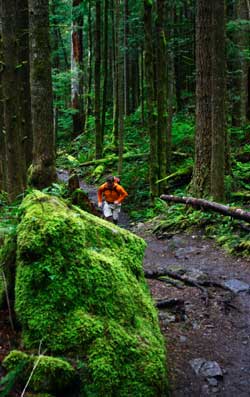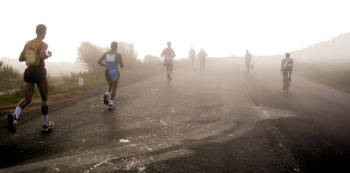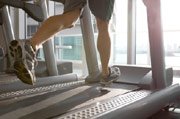Knowing Where To Run
Is Good For Your Running...

As a beginner runner you might be thinking about where to run - how to find the best places for running and what is recommended?
Well, usually you have many choices – the beauty of running, of course, is that you can run almost anywhere
– what we aim to do here is to give you the best running tips and advice on where to run, and how to make the choices which are good for your running survival…
Research shows that by running on a variety of surfaces (hard and soft) you are reducing the risk of injury
For example, if you run on flat asphalt roads all the time, you will use the same muscles over and over again
– whereas, if you also run on soft surfaces such as dirt tracks, trails etc. - and which are usually more uneven - then you engage other muscle groups in your legs (due to how your foot moves on uneven ground), making them stronger and more balanced, therefore reducing the risk of injury
(Cool, eh?)
But finding these places is often a challenge, so here we will explore what options you have in your area and how best to find them
Where To Run Off-Road (and On-Road…)
I prefer to run off road mostly – the air is cleaner, the scenery is usually made up of canals, rivers, trees and wide open countryside. This gives me the perfect place to relax and enjoy my running, and for me there is no better motivation than running while being close to nature – instead of being close to that lorry that didn’t see me..!
Occasionally though, I do run on pavements and roads – especially at night when off-road routes are a bit too dark and spooky!
Also I find busy roads are very useful after heavy snowfall - if the canals and cycle paths are iced over, busy roads (and their pavements) are normally cleared
(Result!)
For off-road running…
- Ask at your local cyclist shop if there are any off-road cycling routes they know of – if you live in the UK, Sustrans have a national network of cycling routes, mostly off-road and ideal for runners!
- Ring local running clubs and ask them where they run off-road – they are likely to tell you) - join one and see where they run for yourself (talk to other runners)
- Get a map of your area and see what park areas there are, fields…
- Look for waterways and canals - canals often have a wide range of scenery and often a soft running surface
Roads and pavements,
- Look for quiet roads which have a small amount of traffic, where possible
- Find roads which have nice scenery, country lanes etc.
- If you do run on busy roads be extra-alert to traffic and watch for junctions
- Run on your local roads to explore the area, housing estates, industry, the lot

TIP: If you have a car use it to travel to the roads which are quiet, find some countryside routes to run on instead of the town where you live
For running safely on roads and other
Running Safety Tips in general, have a look
here
What about running tracks?
if the local school or running club has a running track they will let you use, fine! It might come in handy one day - but I wouldn’t devote any lengthy sessions on them. They do offer a spongy surface but they can kill your motivation, especially if you are a beginner. Good for speed training later perhaps, but anything else? – Personally, no
– talk about déjà vu! (round-and-round-and…), they drive me mad!
But if you want to try them and see, make some enquiries - usually schools won’t mind

Running in the house?
All this talk about where to run, and nobody’s mentioned treadmills..!
Treadmills are not as bad as I thought they would be – they are a lot of fun actually. You can run really effective training sessions on them, some sessions you wouldn’t be able to do outside,
- You can run at an uninterrupted, even pace (good for speed training)
- Do hill training on them by adjusting the incline (great if you have no hills where you live)
- They have a padded running surface, so if you suffer from impact injuries such as knees, running on a treadmill can ease the strain – constantly soft and even
- For an easy run set the program for a slow pace and this will stop you speeding up later in the session, as you would outdoors
- The obvious advantage to having a treadmill is in winter, no matter how bad it gets you can still do your workout - if it’s snowing you can still do your interval running without killing yourself!
If you are considering a purchase make sure the speed of the belt goes above the speed you can run at, some of them only reach up to 6 or 7mph, but if you splash out from £400 upwards you will have no problems finding one. Also look for one with an incline setting
Decided Where To Run Yet?
So, ideally what you are looking for is a mixture of hard and soft surfaces, nice scenery - or a nature program on the TV if on your treadmill :-) – but, if I was you, avoid busy roads if you can, avoiding fumes and partially sighted drivers!
– I’m quite lucky where I live, there’s a cycle path which has a mixture of concrete path, dirt tracks (even surfaces and bumpy) and I can nip down to the canal for a softer running surface, and some puddle dodging - which should be good for my flexibility, no doubt!
(Try Sustrans for UK cycling routes).
If you are short of options on where to run, buying a treadmill might be a viable solution (or try the gym) – you could run on roads / trails 2 days a week and on the treadmill another day or two so you still get a good mixture of running surface
So find a system which you are happy with, giving yourself as many options as possible – if you find many options this is good for your motivation, seeing different scenery and a variety of challenges keeps you occupied
When I think about where to run I always try to keep it as interesting as I can, unusual even –
… so have a think ;-)
To go from Where To Run back to the Home Page click here
